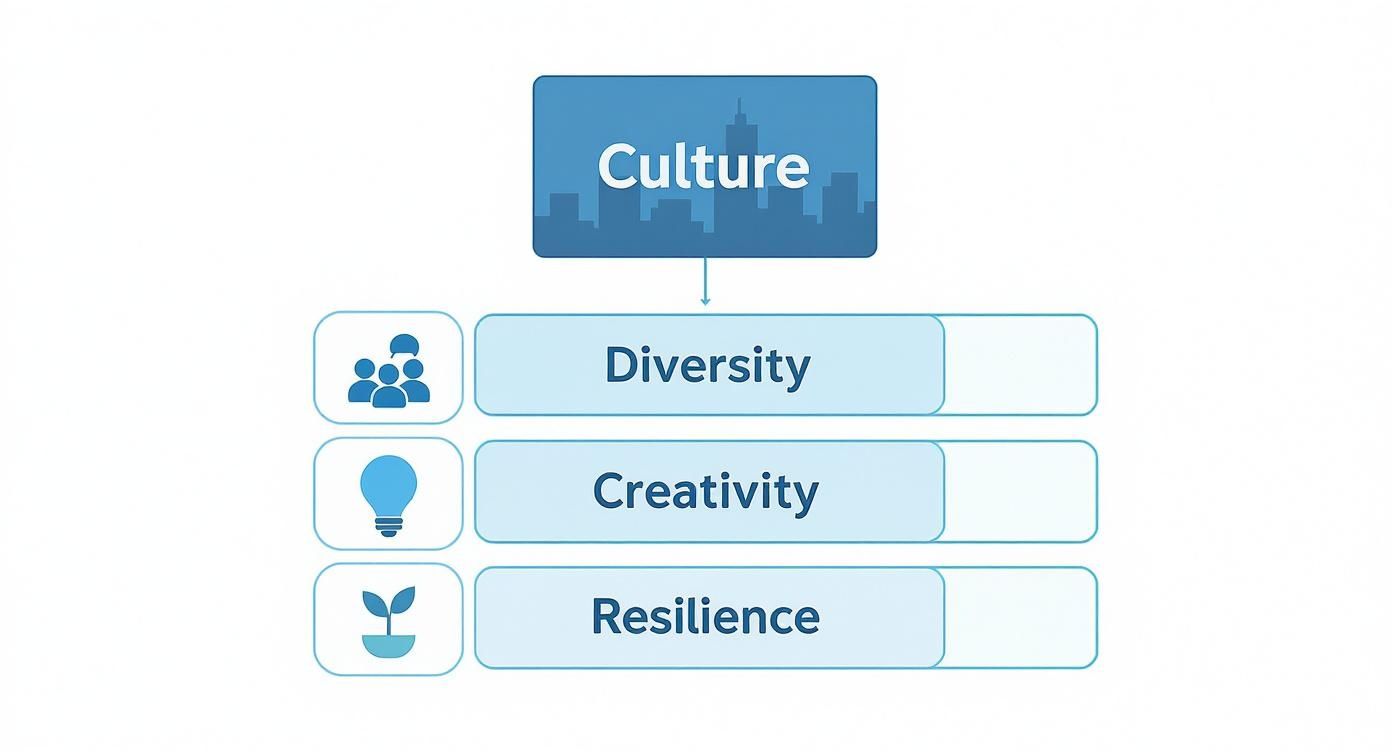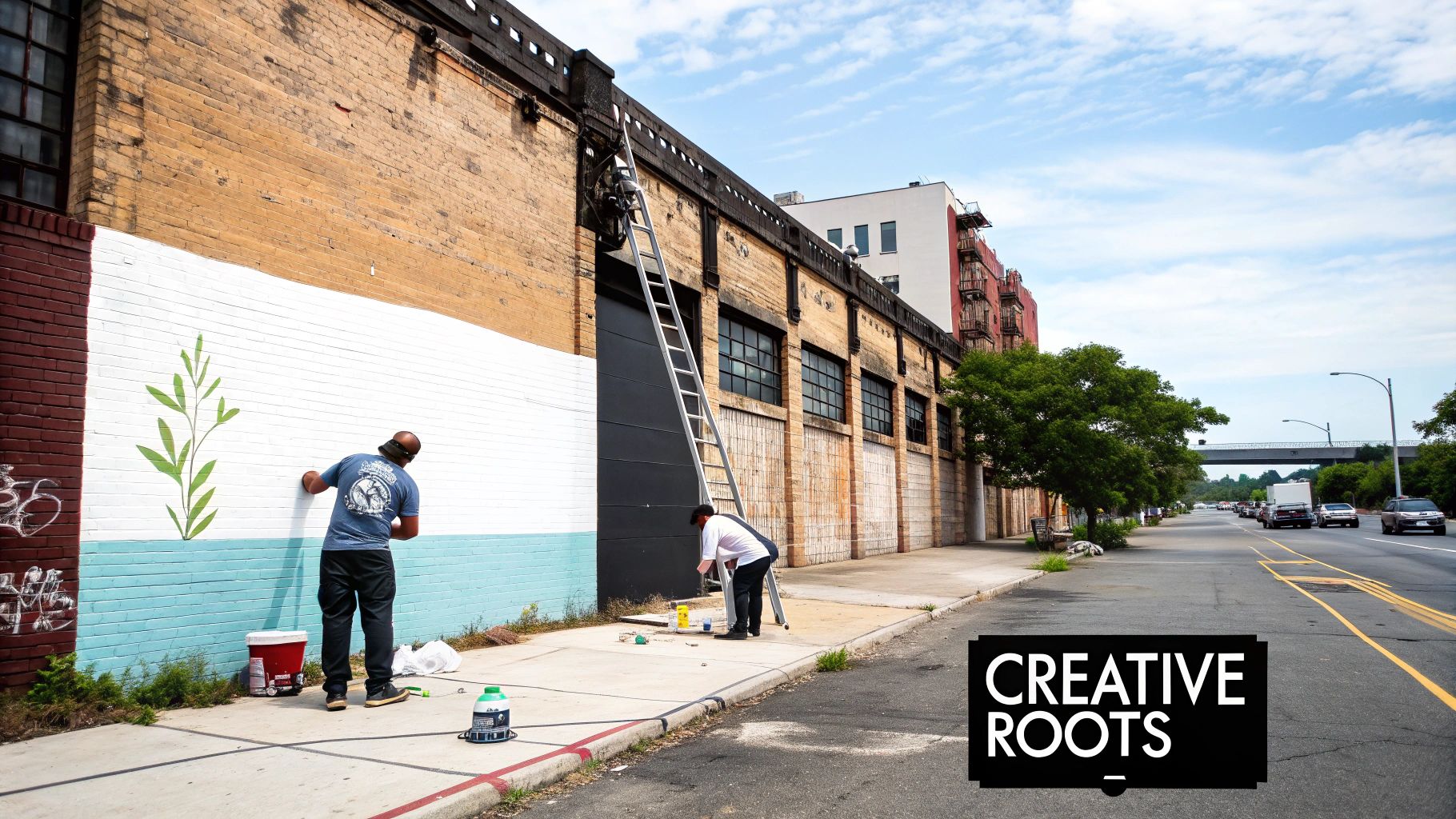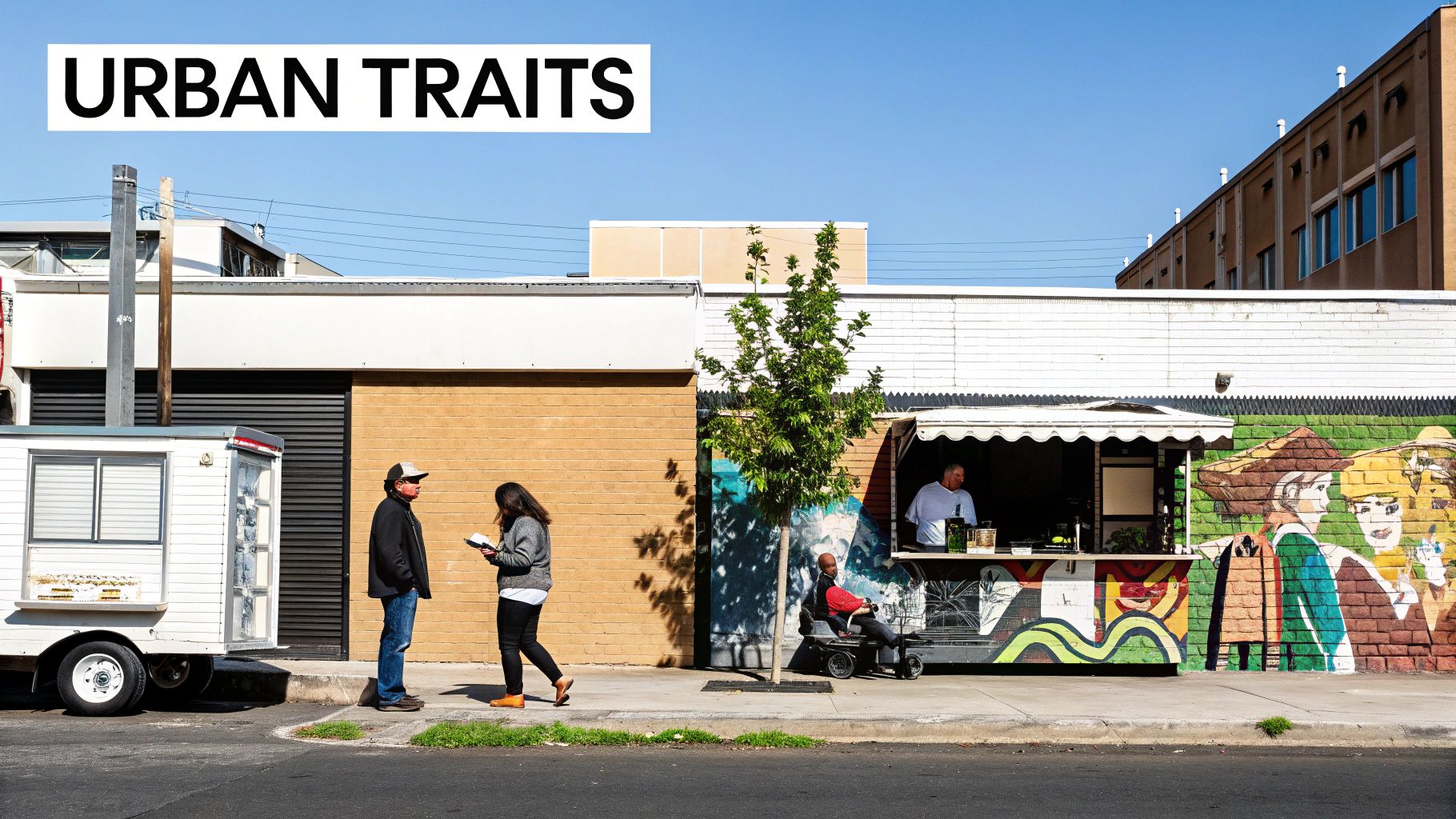To truly grasp the essence of urban culture, you have to look beyond a simple dictionary entry. Think of it as the living, breathing heartbeat of a city—a story constantly being written on its streets, through its art, and within the spirit of its people. We're going to unpack this idea by looking at Brooklyn, a borough that practically pulses with this kind of dynamic energy.
Defining Urban Culture Through Brooklyn's Story
Forget dry, academic definitions. Imagine a vibrant mosaic of creativity, resilience, and diversity, all forged in the intense energy of city life. That, right there, is the soul of urban culture. It’s the collection of customs, art forms, and social rituals that spring up when so many different people share the same concrete jungle.
Today, a staggering 55% of the world's population calls a city home, and that number is projected to climb to 68% by 2050. This massive concentration of people and ideas makes cities incredible incubators for new trends, movements, and ways of life that you just don't find in suburban or rural settings.
The Pillars of Urban Vitality
This visual breaks down the core elements that give urban culture its power and form.

It shows how things like diversity, creativity, and resilience aren't separate ideas but interconnected pillars holding up the entire cultural identity of a place. And there's no better place to see this in action than Brooklyn.
Let's take a closer look at these core pillars and how they come together to create the unique cultural fabric of a place like Brooklyn. The table below breaks it down.
The Four Pillars of Brooklyn's Urban Culture
| Pillar | Core Concept | How It Manifests in Brooklyn |
|---|---|---|
| Diversity | The mixing of different cultures, ethnicities, and backgrounds. | Did you know Brooklyn is home to the largest Caribbean population outside of the West Indies? This cultural fusion fuels everything from the West Indian Day Parade to the incredible food scene. |
| Creativity | The drive to innovate and express through art, music, fashion, and food. | Home to more artists and writers per capita than any other place in the US, Brooklyn's creative energy is legendary, turning warehouses into world-famous art collectives. |
| Resilience | The ability to adapt and rebuild in the face of challenges. | Neighborhoods like DUMBO transformed from industrial decline into hubs of tech and creativity, a testament to the borough's ability to constantly reinvent itself. |
| Community | The creation of shared identity and belonging through local networks. | From fiercely independent businesses to the legendary stoop culture, where neighbors connect and build relationships, community is the borough’s true backbone. |
Each pillar reinforces the others, creating a culture that's constantly evolving yet deeply rooted in its history. This is what makes urban culture so compelling—it's built by the people, for the people.
We're about to explore Brooklyn's incredible journey from an industrial workhorse to a global capital of cool. This will set the stage for understanding how this one-of-a-kind borough became the perfect case study for what happens when people, history, and ambition collide. For a deeper dive, explore our guide on what Brooklyn is known for.
Urban culture isn't just a collection of trends; it's a feeling of belonging built through shared experiences, rituals, and relationships. It’s culture in motion, created by the very people who call the city home.
Join us as we uncover the inspirational force that turned abandoned factory walls into canvases and forgotten neighborhoods into epicenters of creativity. This is the story of how a fierce, independent spirit built a world-renowned cultural identity from the ground up.
The Creative Soul Forged in Brooklyn's History

Brooklyn's vibrant spirit wasn't born overnight. It was forged in the fires of industrial change, built by waves of immigrants, and defined by a uniquely defiant attitude. In fact, Brooklyn was once its own independent city—the fourth largest in America—and it only agreed to join New York City in 1898 after a fiercely debated vote known as "The Great Mistake." That independent spirit never left.
This constant churn of people and cultures laid a rich, complex foundation. When the factories eventually fell silent and the industrial boom faded, it left behind a landscape of empty warehouses and uncertainty. But where some saw only decay, a new generation of creators saw a blank canvas.
This is where the true definition of urban culture comes alive—not as an abstract idea, but as a living, breathing response to the world. It’s that moment when necessity sparks innovation, turning struggle into a creative identity recognized around the globe.
From Grit to Gallery
Think about neighborhoods like DUMBO (Down Under the Manhattan Bridge Overpass). It wasn't always a destination for chic galleries. Back in the late 1970s, it was a gritty, almost forgotten industrial pocket. Fun fact: the name "DUMBO" was actually coined by resident artists who thought such an unattractive name would deter developers and help keep their community affordable.
Drawn by the massive loft spaces and dirt-cheap rent, artists didn't just find a place to live; they built a community from scratch, transforming forgotten spaces into studios and homes. This kind of organic, ground-up growth is the very essence of authentic urban culture.
We saw the same story play out in Williamsburg, where musicians and artists reclaimed abandoned factories, their raw creative energy setting the stage for what would become a global cultural phenomenon.
This history tells us everything we need to know about the what is urban culture definition:
- It’s born from adversity. The borough's post-industrial landscape wasn't a setback; it was the fertile ground where creativity took root.
- It’s community-built. Artists and innovators didn't wait for an invitation. They built their own worlds, their own ecosystems, their own rules.
- It’s fiercely independent. This spirit comes directly from communities that had no choice but to rely on themselves to create something out of nothing.
You have to understand this backstory to really get Brooklyn. Its cultural power today is no accident. It’s the direct result of a resilient, independent soul that refused to be defined by its circumstances, choosing instead to redefine them entirely.
The Unmistakable Traits of a Thriving Urban Culture

So, what truly makes a city’s culture pulse with life? It’s rarely found in grand monuments. It’s in the small, powerful expressions of everyday life—the raw, unfiltered heartbeat of the streets. To truly grasp what urban culture is, you have to see it in motion, and there's no better living textbook than Brooklyn.
Take The Bushwick Collective. This isn't a stuffy museum; it’s an ever-shifting outdoor gallery. Its origin is deeply personal and inspirational: it was started by a local resident, Joseph Ficalora, who wanted to transform the graffiti-covered walls of his neighborhood into a place of beauty and healing after a personal tragedy. Artists from across the globe now come to paint here, turning an industrial landscape into a world-class art destination.
Collaboration and Creation
At its core, a vibrant urban culture is a story of collaboration. Just look at the Brooklyn Navy Yard. Once a symbol of industrial might that built battleships, it fell into decline. Today, it’s been reborn as a groundbreaking hub for tech, design, and manufacturing, home to hundreds of independent businesses. It’s even home to Steiner Studios, one of the largest film production studios outside of Hollywood.
This isn’t just an economic comeback; it's a community of creators and thinkers breathing new life into a historic space. They’re a powerful reminder that a city’s soul shines brightest when people build things together, turning forgotten relics into vibrant centers of creation.
Urban culture thrives in the spaces between things—the alleyway mural, the pop-up market, the shared workshop. It’s an ecosystem where creativity, community, and commerce intersect to create something entirely new and inspirational.
This creative spark isn't just for massive projects. You can feel the entrepreneurial pulse in the one-of-a-kind independent shops of Cobble Hill or taste it in the diverse culinary scene of Sunset Park. Each neighborhood tells its own story, adding a distinct flavor to the borough’s incredible identity. If you're inspired to see it for yourself, our guide to exploring Brooklyn's diverse neighborhoods is the perfect place to start.
This constant evolution is happening worldwide. Around 4.7 billion people—a staggering 58% of the world's population—now call urban areas home. This incredible concentration of humanity fuels both immense challenges and breathtaking innovation, forcing communities to adapt and grow in inspiring ways. You can explore more about these global urbanization trends on World Population Review.
These traits—raw artistic expression, community collaboration, and a fierce entrepreneurial spirit—are the living, breathing elements that define urban culture. They show how a community doesn't just survive; it thrives and inspires the world.
How Brooklyn's Culture Inspires Global Trends

There's something about Brooklyn. Its influence ripples out across the globe, becoming a universal shorthand for what feels authentic, creative, and just plain cool. It’s more than a borough; it’s a brand. From coffee shops in Tokyo to fashion boutiques in Berlin, you can feel a current of inspiration that started right here.
This isn’t about following trends—it’s about creating them. Think about the iconic Notorious B.I.G., born and raised in Bed-Stuy. He didn't just put Brooklyn on the hip-hop map; his storytelling and flow changed the entire genre, turning his personal neighborhood experiences into a universal story of struggle and ambition. That's the power of Brooklyn's creative engine.
The Global Brooklyn Aesthetic
Ever walked into a café and seen exposed brick walls, tables made from reclaimed wood, and those signature Edison bulbs? You're stepping into a design language that was perfected in Brooklyn. This industrial-chic vibe grew organically from artists turning old, forgotten warehouses into spaces full of life. It’s more than just a look; it's a whole philosophy that honors craftsmanship and history.
The borough also became ground zero for the artisanal movement. Think about the boom in craft breweries, small-batch coffee roasters, and handmade goods that put quality first. This “maker culture” caught on everywhere, inspiring a new wave of entrepreneurs to create tangible products with a real story behind them. It all stems from a belief in doing things your own way, with your own hands.
The global "Brooklyn Brand" isn't just about style; it's about a spirit. It represents a commitment to authenticity, community, and the belief that creativity can flourish anywhere, turning local heroes into global icons and proving that a neighborhood can indeed change the world.
From Local Stages to Global Playlists
The indie music scene that exploded out of Williamsburg and Bushwick venues didn't just create a new sound for New York; it echoed across the world. Bands that got their start in tiny, cramped practice spaces suddenly had international fans, all drawn to a raw, honest sound that felt like a breath of fresh air compared to polished pop.
This is the very essence of the what is urban culture definition in action. It’s how a hyper-local expression—whether it’s music, fashion, or food—grows beyond its roots to shape a global conversation. Brooklyn's journey is a powerful, living example of how a community-driven culture can become a true cultural superpower.
Imagining the Future of City Culture
So, where do we go from here? What does the future hold for the culture of our cities? If we use Brooklyn's constant reinvention as our guide, we can start to see both the hurdles and the incredible possibilities on the horizon.
At the heart of it all is a tension every creative hub eventually faces: how do you keep that raw, authentic soul alive when the world discovers just how cool you are?
But this isn't a story about selling out. It’s an inspiring call to action. The lessons learned on the streets of Brooklyn serve as a powerful roadmap for other cities wrestling with the same questions. It’s a story about celebrating diversity not as a quota, but as the very lifeblood of creativity and innovation. It's about uplifting local artists and entrepreneurs as the true keepers of a city’s spirit.
This conversation couldn't be more urgent. By 2025, a staggering 4.8 billion people are expected to call urban areas home, making cities the undeniable center of the human story. This incredible density is what sparks urban culture into life, and understanding this shift is everything. You can explore more on these global urban population trends on Our World in Data.
A Blueprint for Tomorrow's Cities
Shaping the future of city culture isn't something that just happens; it requires deliberate, thoughtful choices. It means creating systems that actually support the creators, fighting to protect the spaces where history was made, and ensuring the very people who built the culture can afford to stick around and see it flourish.
This is the real work of cultural preservation.
Of course, technology will connect creative communities in ways we can't even imagine yet. But the most vital ingredient will always be human. It's about nurturing innovation from the ground up and placing fairness at the absolute center of growth and development.
Brooklyn teaches us a fundamental truth: the strongest, most vibrant urban future is built on a foundation of inclusivity. It’s a future where every voice matters, every story is honored, and the collective creative spirit is the most valuable asset a city has.
By embracing the lessons from Brooklyn’s journey, cities all over the world can build a future that is not just innovative and exciting, but also just and deeply inspiring for everyone who calls it home. Dive deeper into this important mission in our article on what is cultural preservation.
Common Questions About Urban Culture
As we dive into the world of urban culture, a few questions always seem to surface. They're good questions, too, because they get right to the core of what makes city life so electric. Let's tackle some of the most common ones, with Brooklyn's incredible story as our backdrop.
What's the Main Difference Between Urban Culture and Pop Culture?
Think of it like this: urban culture is the kitchen where the recipe is invented, and pop culture is the worldwide restaurant that serves the final dish. Urban culture is what bubbles up from the ground level—the raw, unfiltered reality of a community. It’s early hip-hop born in a Bronx community center or street art sprayed on a forgotten wall in Bushwick.
Pop culture is what happens when the world takes notice. It’s when those local, authentic movements get polished, packaged, and broadcast to the masses. One is the gritty, original manuscript; the other is the best-selling book.
The true genius of a place like Brooklyn is its unending ability to create from the ground up. It’s a constant source of authenticity that inspires creativity far beyond its own streets, proving that real influence always begins with a genuine story.
How Can I Experience Brooklyn's Authentic Culture as a Visitor?
To really feel the borough’s pulse, you have to step off the beaten path and into its daily life. Forget the big tourist spots for a moment. Instead, wander through the incredible street art murals in Bushwick or find a family-run spot for dinner in Sunset Park or Crown Heights.
Catch a live band at a small, independent venue in Williamsburg or feel the buzz of creativity at an artist’s open studio in Gowanus. You won’t find authentic culture in a guidebook—you’ll find it in the rhythm of its neighborhoods and the proud spirit of the people who call them home.
Is Gentrification a Threat to Brooklyn's Culture?
This is one of the most pressing challenges facing authentic urban cultures everywhere, and the answer is complicated. While new development and investment can bring benefits, it often comes at a steep price, pushing out the very artists, families, and creators who gave the neighborhood its soul in the first place.
The fight in Brooklyn right now is to figure out how to grow without erasing its history. Countless local groups are working hard to preserve cultural landmarks, protect affordable housing, and support the creative community that remains the true heart of the borough’s powerful identity.
Wear the story of the city that inspires the world. The Brooklyn Initiative offers limited-edition graphic tees that celebrate the authentic, creative soul of Brooklyn. Shop our collection and carry a piece of the culture with you.